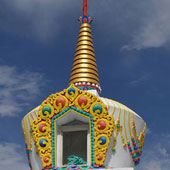Design Resource
Practicing Peace
‘Life, learnings and more from Ladakh’
by
‘May you live a long life. May your journey be safe. May all obstacles disappear from your path’ – are some of the messages printed onto the prayer flags that are characteristically found tied in the most remote areas of Ladakh.
Originally written on cloth banners the Indian Sutras were shared with other regions across the world as prayer flags.
Sometimes used to mark the presence of a monastery, prayer flags can also be found draped across bridges, tied onto bikes and cars making long journeys, waving in the wind blowing through treacherous terrains and pinned onto home, shop fronts for good luck.
‘Lung–Ta’ the horizontal, rectangular prayer flag and ‘Darchor’ the vertical flag are the two different types that can be seen all over Ladakh. The belief is that if hung in high places the blessings depicted on the flag will be carried all over the region. When the wind touches these flags the air is sanctified and becomes pure, emanating good vibrations.
In a region where oxygen is less, temperatures can hit an all time low, ice covered roads that prevent any form of transportation, communication heavily dependent on the fragile network and economy running only on 5 months of tourism; people have to keep hope. They have to have faith.
Prayer flags, apart from being auspicious are symbols of hope. They give an identity to the region of Ladakh. They are often in sets of five colors, blue, white, red, green and yellow in that order, fluttering in the strong winds. Blue symbolizes the sky and space, white symbolizes the air and wind, red symbolizes fire, green symbolizes water and yellow symbolizes earth.











